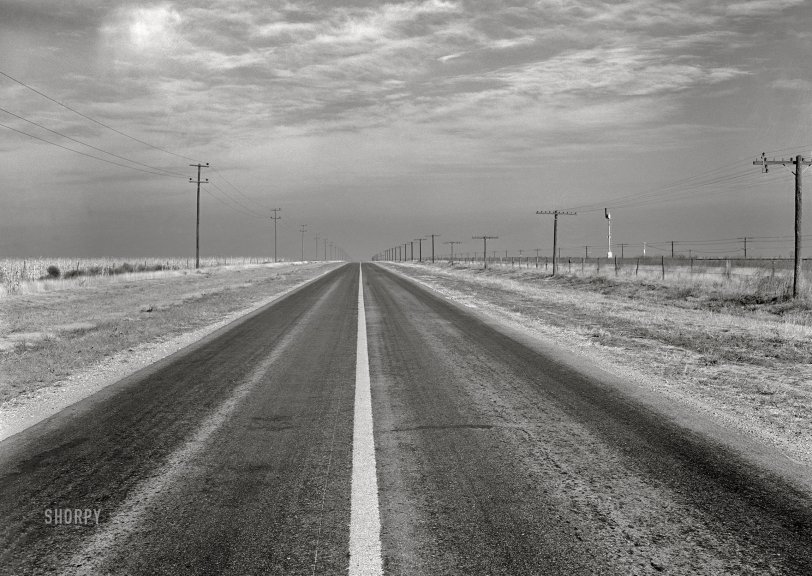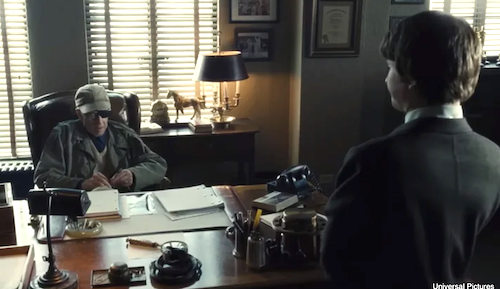


Framed or unframed, desk size to sofa size, printed by us in Arizona and Alabama since 2007. Explore now.
Shorpy is funded by you. Patreon contributors get an ad-free experience.
Learn more.

- Lofty addition
- In 1912
- Keenan Building
- Six years old
- Taken from the P.J. McArdle Roadway?
- It stood only 47 years
- Three track mind
- Incline to the right
- Reach for the sky, 1912 style
- No clean sweep
- Same Job Title, Same Face
- Sadly Lost
- Beautiful ...
- Where you get your kicks
- Aim High
- Pueblo Revival sisters
- Pueblo Neoclassicism
- Milk Man
- Regional dialect.
- Spielberg's inspiration
- Great Photo
- Loaf Story
- Do you still have the Rakes category?
- Could almost be a scene from the 1957 movie 'Hell Drivers'
- The Wages of Fear.
- Conspicuous by their absence
- Got Milk?
- All that aluminum
- No lefties
- Smoke 'em if you've got 'em
Print Emporium
Lonesome Highway: 1942

November 1942. "Deaf Smith County, Texas. Panhandle highway." Medium format acetate negative by John Vachon for the Office of War Information. View full size.
That Semaphore
That railroad semaphore must certainly be a part of the Atchison, Topeka & Santa Fe Railroad's trans-continental line. To Chicago in one direction and to the West Coast in the other direction. The Santa Fe was described by Fortune magazine in 1948 as THE top railroad in the U.S.
John Ford was not always right
"Put the horizon in the middle and it's BORING." So said director John Ford to teenage Steven Spielberg (an event reproduced in "The Fabelmans").
John Vachon clearly found an exception.

Where God lost his shoes
As my good friend would say.
Not there
I find it ironic that, to Google, a search for "NOWHERE, TX" suggests "Now here" as a possibility.
POV
As an artist for many years, I see the Point of this photo. The Point Of View (POV) that is.
As an art major all of my instructors and professors made it a point (forgive the pun) to stress the importance of using POV as a guide to the whole drawing/painting.
Only then could you have a piece that reflected an almost true to life landscape/portrait.
This photo in my mind is an excellent example of that art illusion.
Note: If you want to see a master of the POV look up Maurits Cornelis Escher (M.C. Esher). You will then understand the importance of POV.
Flat doesn't begin
The comment about it being flat only hints at it, this part of the plains makes Kansas look like the Swiss Alps. It is actually a bit unsettling to drive through there.
Still lonesome
As can be seen in Doug Floor Plan's post, that stretch of US60 is now four lanes. Whatever prompted the highway folks to do that is a mystery. The "Lonesome Highway" moniker is as appropriate now as then.
"White line fever"
Highway hypnosis, a phenomenon truckers know well.
https://www.pridetransport.com/news-and-events/tired-or-fever-the-white-...
Middle of Nowhere
Go another 270+ miles east and you'll probably be in the middle of Nowhere.
I am a lineman for the county --
That's all I have today.
The land is vast and unbelievably flat
Truman Capote was describing Kansas, but he could have just as easily been describing Deaf Smith County, or most of the Texas Panhandle. I've always compared this part of the world to living at the beach. You're able to look out and see to the curvature of the earth. Structures that are miles and miles away are clear and recognizable, like ships far out at sea.
Unfortunately, the flat landscape also lets weather fronts blow right through. There was a time, in the early 1970s in Lubbock, when clear, warm skies were replaced by a dust storm, then a light rain (making everything that was covered in dust now covered in mud), then snow ... all within a 24hour period. After a dust storm, your parked car with the windows rolled up would have dust across the dashboard.
Transposition of Wires
On the left side of the highway there are electric power lines, and on the right side telephone wires on insulators. At the far right of the photo there are four wires on insulators that have been placed on a bracket to change their position on the next pole. This is called transposition. It helps prevent "crosstalk" between the wires - two wires close to each other with different signals. I first noticed this on train trips, and the railway in the distance has signal and telegraph lines that would also transpose the wires. You can see a wire connection to the semaphore signal beside the tracks.
En Route to Amarillo
This is looking northeast on US 60, probably between Hereford and Dawn.
Erastus Smith
The county was named for Erastus "Deaf" Smith (1787–1837), a partially deaf scout and soldier who served in the Texas Revolution, and was the first to reach the Alamo after its fall in 1836. The pronunciation of "Deaf", as used by Smith himself, is /diːf/ DEEF; however, most residents pronounce it /dɛf/ DEF.
























On Shorpy:
Today’s Top 5